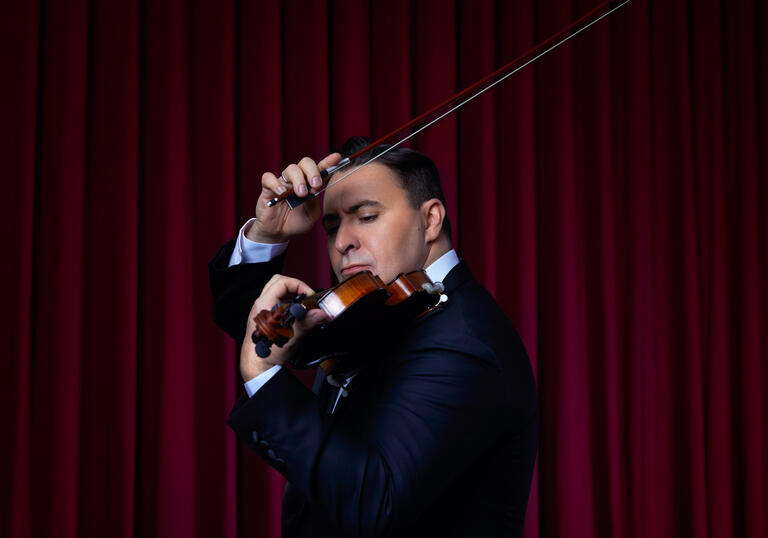In 1853 Düsseldorf was home to two leading lights of German music: Clara and Robert Schumann. After living at several addresses, they moved to a large flat on the city’s Bilkerstrasse, where there was room for their six children – and for Clara to have her own space to practise the piano and to return to composition. She was a concert pianist, whose fame when she was younger had far eclipsed that of her husband; he had, three years before, been appointed municipal director of music in the city, his first major public post, which brought both triumphs and turbulence. Both musicians were composers, though, as a woman, Clara had long doubted her suitability to compose. Yet that year she let her creativity flourish, writing her Three Romances for violin and piano, Op 22: three lyrical instrumental pieces that are now regarded as some of her finest works.
Clara dedicated the pieces to the violinist Joseph Joachim, a close friend of the Schumanns, and together they took them on tour. The opening Andante molto is a wonderfully tender outpouring, with violin and piano weaving around each other, a contrast to the wistful Allegretto. And in the impassioned final movement, the piano ripples under long violin lines.
On 1 October 1853 Robert finished his own piece for Joachim, a violin concerto. In the couple’s housekeeping book, he also noted that they had a ‘visit from Brahms (a genius)’. Clara was even more effusive. ‘This month brought us the wonderful arrival of the 20-year-old composer Brahms from Hamburg. It is as though he has been sent by God himself!’ The Schumanns were bowled over by the talents of their new acquaintance, who had been introduced to the family by Joachim. And the friendship sparked an idea for Robert. How about a violin sonata written by three composers – Robert, Brahms and Albert Dietrich (one of Robert’s pupils) – based on the three letters that spelt out Joachim’s personal motto: Frei aber einsam (‘free but lonely’)? Brahms contributed a Scherzo to the F-A-E Sonata, while Robert wrote the intermezzo and finale. On 28 October, at a soirée at the Schumanns, they gave Joachim the score as a welcome gift – and asked him to guess who had written which movement, a puzzle he easily solved.
Listening to the tempestuous Scherzo, many of the hallmarks of Brahms’s style are already there, particularly the lively cross rhythms and motivic energy. While Brahms’s standalone movement didn’t ever find another home, it only took Robert two days to sketch two more to refashion his contribution as his Third Violin Sonata in A minor. In the next few months, his health began to deteriorate drastically, with aural hallucinations that ranged from single notes to an entire wind band. In early 1854 he attempted suicide, throwing himself into the Rhine. Rescued by fishermen, he was taken to an asylum in Endenich, and Clara was not allowed to see him for another two years, tragically seeing him for the first time just two days before his death. Schumann’s Third Sonata was only finally published in 1956 – and for many years was written off as being the product of madness, a view that has been challenged in recent times. What is not in question is that its four movements offer music of intensity, wildness and passion.
After Russia’s October Revolution of 1917 Sergei Prokofiev left his home country, bound first for the US and then for Europe. While he was in California in 1920, making the most of his time while there were wranglings over the premiere of his opera The Love for Three Oranges, he worked on his Five Melodies for the Ukrainian soprano Nina Koshetz. Five years later, when he was in Paris, he transformed them into vivid works for violin and piano. With the vocal line easily transferred to violin, these songs-without-words are intense, lyrical and wonderfully expressive. Prokofiev worked with the violinist Paul Kochanski to create his transcriptions, so it’s perhaps no surprise that the results are highly idiomatic, making full use of the instrument’s capabilities, with double stops, pizzicatos, harmonics, trills and muted passages.
A couple of decades later, in 1943, Prokofiev was busy working on his score for Eisenstein’s film Ivan the Terrible, in the capital of Kazakhstan, where the Russian film industry moved during the Second World War. He found himself needing another creative outlet, and the idea of a ‘sonata in a gentle, flowing Classical style,’ appealed. He promptly set about writing his Flute Sonata in D, Op 94 – inspired by the playing of French flautist Georges Barrère, whom he’d got to know during his decade in Paris. The piece caught the attention of violinist David Oistrakh, no less, who nudged his composer friend to transform the sonata into one for violin and piano. Now in the city of Perm, on the edge of the Ural mountains, Prokofiev obliged – and the Second Violin Sonata was the result.
The sonata has, as the composer hoped, a flowing Classical – or perhaps neo-Classical would be a better description – style, particularly in the fluid, serene violin line of the opening Moderato. That’s not to say the mood is consistently sunny: shadowy undercurrents and spiky outbursts play their role too. An impish Scherzo scurries along, both delighted and sardonic, with the piano and violin in constant conversation. The gentleness Prokofiev spoke of infuses the Andante, along with a certain melancholy and a nod to the blues, before ending on a high with an energetic finale.
© Rebecca Franks

